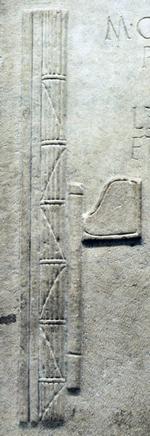Fasces
Fasces: set of rods bound in the form of a bundle which contained an axe. In ancient Rome, the bodyguards of a magistrate carried fasces.

The word fasces means "bundle" and refers to the fact that it is a bundle of rods, which surrounded an ax in the middle. In ancient Rome, the lictors carried fasces before consul, praetors and dictators, i.e., magistrates that held imperium (which means that they had the right to command and interpret the flight of the birds). Other people escorted by lictors with fasces were Vestal Virgins, governors, and the commanders of legions.
During the empire, the fasces of the emperor were distinguished from those of the magistrates by laurels. This was a republican custom, however: on festive occasions (e.g., a military victory), fasces could be crowned with laurel. On the other hand, when the city was in mourning, the fasces were sometimes cloaked. If the ax was left out, it could mean that the magistrate wanted to request something from the people or had something to apologize for.
The fasces were a symbol of authority, but the precise meaning is unknown. It is often claimed that the rods could be used to lash people, and the ax to execute them. This may have been true in the days of the monarchy, but not during the republic. After the Laws of the twelve tables, no Roman magistrate could summarily execute a Roman citizen.
The Romans believed that the fasces were introduced in Rome from Etruria. Again, this may be true, but the tradition is open to some criticism. So far, only one set of fasces has been found in Etruria, in the Tomba del littore near Vetulonia, in 1890. This find has been hailed as a confirmation of the tradition, but it should be noted that the archaeologists only found a lot of small rusty flakes, which were interpreted as Etruscan fasces, which, they had to admit, were not identical to Roman fasces. They were entirely made of metal, the ax had two blades, and finally: the Etruscan fasces were extremely small. It has been said that the find from Vetulonia is only a miniature model, but this is poor method: to rescue an interpretation, one introduces a hypothesis.
Of course, doubts about this find do not prove that the fasces did not come from Etruria. One argument for this tradition is that the least unconvincing etymology of the word lictor is that it is derived from a Etruscan word that means "royal" (more).
In the eighteenth century, the fasces received a second life, when the young United States and republican France started to use ancient Roman symbols. Both were progressive revolutionary nations that imitated the Roman republican constitution.
The use of fasces by the Italian dictator Benito Mussolini is quite another story. In 1921, he called his political movement Fasci di combattimento, fascio being the Italian word for peasant organizations and labor unions. When il duce chose the ancient Roman fasces as symbol of the fascist party, he was at the same time playing with the similarity of the words fascio and fasces, chosing an ancient symbol, and drawing a parallel between fascism and progressive movements of the past.